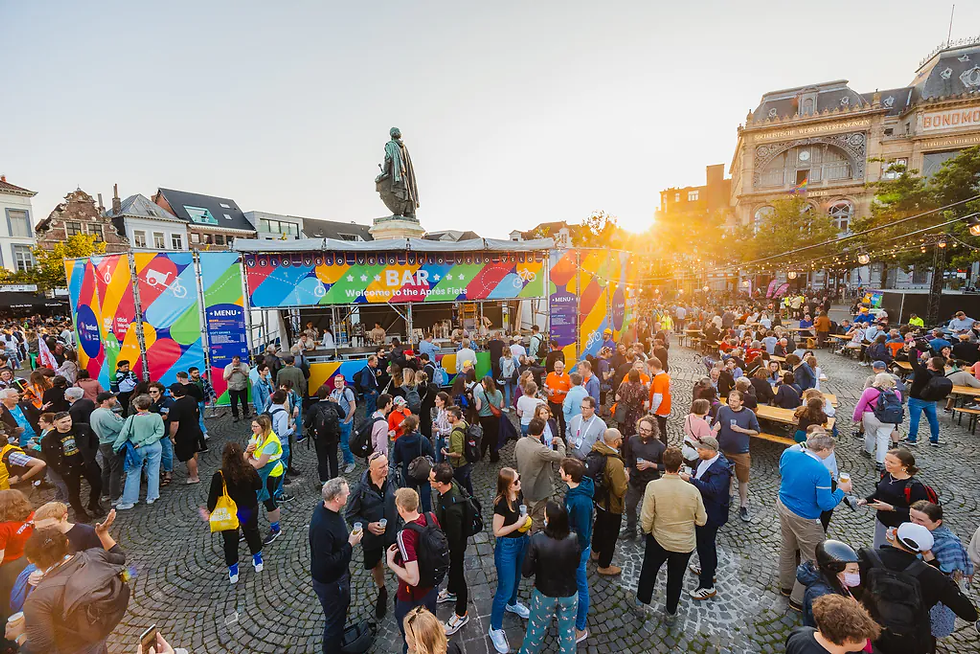Velo-city Ghent — Day 4: Notes from the world’s biggest cycling conference (and why we went)
- David Everard

- Jun 20, 2024
- 4 min read
Why we’re here.
We came to Ghent for the same reason our clients hire us: to turn good intentions into practical steps. Velo-city is the world’s biggest cycling conference, and day three delivered a sharp mix of data, dialogue, and doing. Below are our field notes from the three sessions we attended—and a few thoughts on how we’ll translate them for projects back home.
1) Data you can actually use
Mapping what exists (and what’s missing).
The European Cyclists’ Federation showed how OpenStreetMap can now quantify cycle infrastructure across 37 countries / 1,502 regions—about 450,000 km identified, of which 370,000 km are segregated. That dataset lets cities compare themselves and, crucially, pinpoint the ~100,000 km of missing links in EU “urban nodes.”
Travel times, not just counts.
Strava Metro’s “Travel Times” feature flips the script from how many to how long, revealing realistic 15-minute access by bike across cities—from Ghent to London, San Francisco, Barcelona, Sydney and NYC. The tool is available free to public agencies and helps spot slow segments where small fixes unlock big gains.
Copenhagen’s recipe.
Three reminders from Copenhagen’s data practice: consistency beats intensity, look for systemic bottlenecks (not just shiny projects), and remember that cycling data is really about the whole city system, not bikes in isolation.
French dashboards that persuade.
Vélo & Territoires demoed national platforms (Velodatamap, traffic dashboards) that help local authorities justify investment—with live indicators, route maps, and the ability to cross accident data with usage. Decision-makers get a single, trusted view.

2) Managing the conversation (because projects are human)
Change is emotional before it’s technical.
A communications session walked through the Kübler-Ross change curve applied to street changes (shock → frustration → experimentation → integration). The point wasn’t theory; it was to plan different messages for different moments—and for different audiences (innovators, mainstreamers, laggards).
Safety vs. feeling safe.
Denmark’s cycling knowledge centre distinguished measured road safety (crash data) from perceived safety (the story people tell themselves). Narratives matter: cars are the primary source of perceived risk; gaps in infrastructure amplify it. Plan for perception and be careful how you talk about crashes in public updates.
Winter truth-telling from Helsinki.
We loved this: if commuting choices are made the night before, then proactive, weather-specific messaging about winter maintenance (e.g., snowstorm, frost, freezing rain) raises satisfaction even when conditions are tough. The advice: signal what will be done and when paths will be rideable again—with plain thresholds.
Radical transparency in Berlin.
With dozens of delivery entities and endless inquiries, Berlin built a shared project database and a public map portal to show network goals and live project status. Transparency isn’t a slogan; it’s an information product that saves staff time and builds trust.
What we’ll bring to clients:
draft a communications playbook alongside the engineering plan—audiences, timelines, message templates (including “bad-weather honesty”), plus a public tracker that answers the “are we moving?” question at a glance.

3) Making intermodality real
Zagreb: the long game.
A candid look at bike-with-PT: 116 km of tram, 260 stops, 148 bus lines—and experiments like BikeOnBus on specific corridors. Not every pilot scales (a cable car replaced one popular route), but momentum builds through PT priority, re-seeding bike stands, and a city bike scheme in procurement.
Basel: simple, secure Bike-&-Ride.
Basel’s recipe is strikingly down-to-earth: recognisable design, weather protection, secure, and free—with a typical cost of ~CHF 50,000 per station (35% federal co-funding), rolling out toward 30 sites. Intermodality starts with a safe place to leave your bike.
ADFC’s five pillars.
A neat framework to connect bikes and transit: Bike+Ride, bikes on vehicles, bike-sharing, infrastructure, and planning/mobility management. Use it as a checklist; weak links reveal themselves quickly.
What we’ll bring to clients:
prioritise frictionless transfers (B+R first), pick corridors where bikes feed transit.
Why we attend (and how this helps you)
We come to Velo-city to gather workable ideas—tools you can deploy in small cities and complex governance settings. Day one gave us exactly that: measurable baselines, a smarter public conversation, and practical intermodality. If you’re working on a mobility plan, we can help you:
build a lightweight evidence spine and public dashboard (OSM + travel times + KPIs),
script a communications cadence that respects how people experience change, and
design low-friction transfers between cycling and public transport.

Four days, one through-line.
Velo-city Ghent was a reminder that better mobility isn’t one big leap—it’s many small, connected steps. Across the week we saw the same pattern repeat: start with a clear evidence spine (what’s really happening on the street), pair it with an honest, human conversation (what people feel and need), then make transfers effortless between modes so the whole system clicks. From practical data tools to winter-proof communications and no-drama Bike+Ride, the best ideas were simple, testable, and shareable. We came home with playbooks we can put to work: lightweight dashboards to track progress, message templates for tricky moments, and pilot designs that reduce friction where it matters. Most of all, we were reminded that good projects feel respectful—of people’s time, of daily routines, and of the city as a living network. That’s the spirit we’ll carry into our work with clients in the months ahead.






Comments